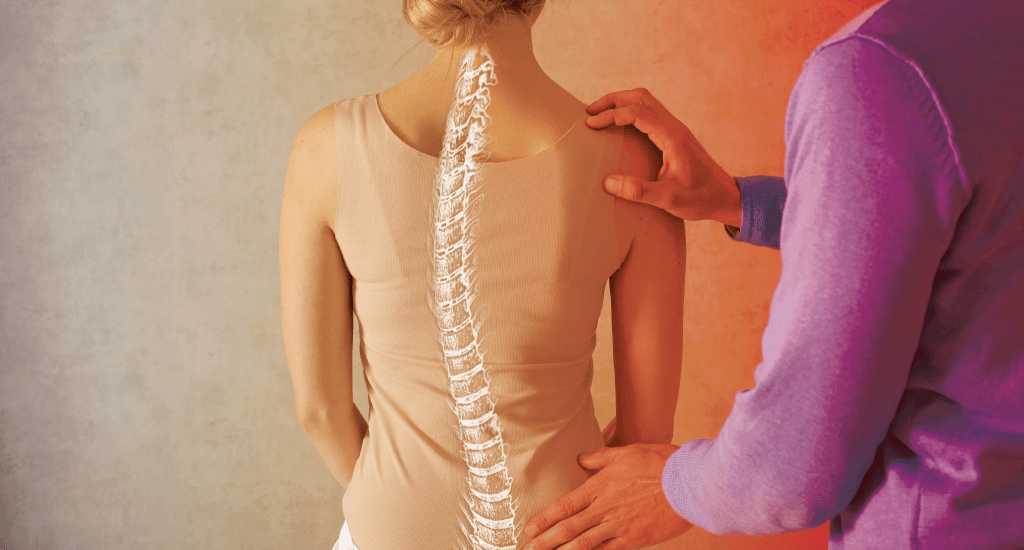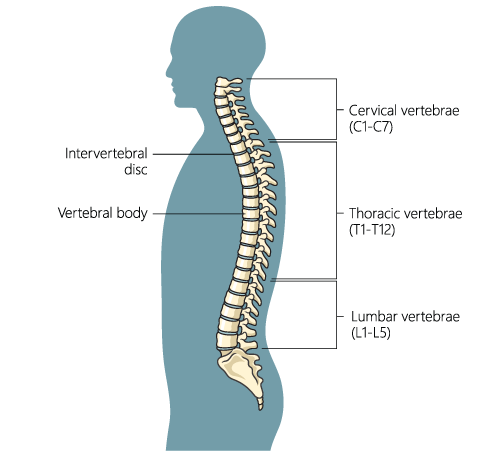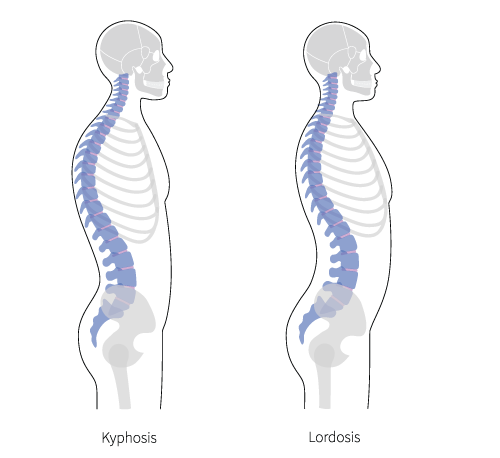
Can Chiropractors Reduce Scoliosis Pain?
When it comes to your spine, a little curvature is a very good thing. But like many things in life, too much of a good thing can quickly turn bad. How your spine curves and how much it curves can both significantly impact your mobility and quality of life. Improper spinal curvature can be the cause of significant pain and even impair the way you move.
Scoliosis is a condition which causes abnormal spinal curvature. While most people think of it as a childhood condition – it is usually diagnosed between the ages of 10-15 – the condition affects 7 million adults — and can arise seemingly out of nowhere as you age.
While some types of curvature can be the result of your habits – such as poor posture, extended sitting, driving, or standing – for more than 80% of scoliosis cases, there is no known cause. The condition can lead to severe spinal problems and deformities, imbalances in the shoulders, waist, or hips, as well as pain, discomfort, breathing issues, and other symptoms. Chiropractic care can help you find relief.
The Ins and Outs of Spinal Curvature
A healthy spine has four curves. Together they allow you to bend, twist, reach and generally move the way you want. These natural curves provide balance, stability, and cushioning needed to maintain good posture and range of motion. They’re also vital for proper alignment, spinal cord protection, and supporting your ligaments and muscles.
The four curves of the spine are:
o Cervical. This curve lives at the top of your spine where it meets the base of the skull and contains with 7 cervical vertebrae. If you nod forward and reach your hand to where your neck meets your back, you’ll likely feel a bone sticking out. This is C7 – the 7th cervical vertebrae. When healthy, this is a lordotic or forward curve.
o Thoracic. Below C7 are the 12 vertebrae that form the thoracic curve. The thoracic vertebrae connect to the ribs and curve in the opposite direction of the cervical spine, allowing the heaviest part of your torso (the part containing your internal organs) to stay balanced over your center of gravity. When healthy, this is a kyphotic or backward curve.
o Lumbar. Next is the lumbar curve of the spine, consisting of 5 vertebrae and connecting to the pelvis. The lumbar vertebrae curve back in the same direction as the cervical spine, bringing your pelvis underneath you, rather than protruding behind you (as you do when in kyphosis). When healthy, this is a lordotic or forward curve.
o Sacral. Below the lumbar are 5 sacral vertebrae and 4 coccyx bones. Once we reach adulthood, the sacral vertebrae fuse to form the sacrum (the broad bone in your lower back just opposite your hip bones), and the 4 vertebrae below fuse to form the coccyx, or tailbone. When healthy, this has a kyphotic or backward curve.

The thoracic and sacral are primary curves; these curves are developed before you’re born. The cervical and lumbar curves develop after birth.
Poor Posture and Your Spinal Curves
While kyphotic and lordotic describe the angle of spinal curvature, kyphosis and lordosis can mean something else altogether.
There are two types of spinal curvature:
A kyphotic curve: curves inward toward, forming a backward C shape. A lordotic curve: curves outward, creating a standard C-shape. When these curves become exaggerated, due to habits like poor posture, for example, they can begin to cause pain and other symptoms.
- Kyphosis is an exaggerated, forward rounding of the upper back.

- Lordosis is an exaggerated inward curve of the spine that typically affects the lower back.
Poor posture, trauma, neuromuscular conditions, and carrying excessive weight can all lead to kyphosis or lordosis.
When your spine’s curves are forced into opposite directions, it causes stress and ligament damage which typically results in hyper-mobility. This hypermobility makes your joints unstable and puts them at a higher risk of injury and dislocation.
More Than Just a Curve: Understanding Scoliosis
Scoliosis is an abnormal lateral – or sideways – curvature of the spine. This may sound simple, but the symptoms of scoliosis can be varied and severe, depending on the severity of the curvature, its progression, and onset of intervention.
Customizing a treatment plan to help relieve your scoliosis pain is a complex undertaking. Understanding a bit about the biomechanics of your spine and the different types of scoliosis will help you understand how critical it is for you to have a full evaluation before beginning treatment for scoliosis pain.
Scoliosis is often defined as spinal curvature in the “coronal” (frontal) plane. While the degree of curvature is measured on the coronal plane, scoliosis is actually a more complex, three-dimensional problem which involves the following planes:
- Coronal plane – a vertical plane from head to foot, parallel to the shoulders, dividing the body into anterior (front) and posterior (back) sections
- Sagittal plane – divides the body into right and left halves
- Axial plane – parallel to the plane of the ground and at right angles to the coronal and sagittal planes
Scoliosis can be classified three ways:
- Idiopathic scoliosis:Idiopathic scoliosis accounts for about 80% of all cases. Doctors typically make this diagnosis only when all other causes are excluded. This is the type of scoliosis we treat most often in our clinics.
- Congenital scoliosis. Patients with this type of scoliosis are born with the disorder. Congenital scoliosis can occur in any part of the spine, and involves malformation of one or more vertebrae, causing curvature and other deformities as one area of the spinal column lengthens at a slower rate than the rest.
- Neuromuscular scoliosis. This diagnosis indicates scoliosis that is secondary to neurological or muscular diseases such as cerebral palsy, spinal cord trauma, muscular dystrophy, spinal muscular atrophy and spina bifida, and typically progresses more rapidly than idiopathic scoliosis, often requiring surgical intervention.
From Painless to Painful: the Range of Symptoms that Can Accompany Scoliosis
Not everyone who lives with scoliosis experiences pain. Children and teens are less likely to have pain or complications than adults. However, for both adults and kids alike, symptoms of scoliosis may include:
- Asymmetry in the shoulders
- One shoulder blade that protrudes further than the other
- An uneven waist height
- One hip that sits higher than the other
- The rib cage may protrude forward on one side of the body
- One side of the back will appear more prominent when bending
In most people living with scoliosis, the spine will not only curve, but rotate or twist side to side, which is what causes asymmetries and protrusions of the ribs or muscles.
Adults living scoliosis often experience achiness or stiffness in the mid to low back. Also common is numbness and weakness in the legs. In severe cases, scoliosis can impact your sciatic nerve, causing radiating pain down the leg. Back pain may become worse when standing or be more noticeable at different times of day, such as at night or first thing in the morning.
Pain tends to be worse when in an upright position — either standing or walking — because it puts more pressure on the nerves. That’s why many patients suffering from this condition lean forward in their chairs or when holding onto a walker or shopping cart. These positions help take pressure off the nerves.
But Why Does Scoliosis Cause Pain?
Just like postural issues can cause pain by putting pressure on the spine and causing tension in your muscles – a series of imbalances that cause a domino effect in the body – the sideways curvature distinct to scoliosis causes pain by impacting the entire neuromuscular system, starting with the vertebrae.
Your spine has a series of facet joints that connect your vertebrae. Those joints help you bend and twist. They also connect nerve roots throughout your body. Along with facet joints, your spine has intervertebral discs between each vertebra to cushion your spine and to absorb shock. Each disc has a soft gel-like center called the nucleus surrounded by a thick, fibrous outer protective layer called the annulus.
The side-to-side spinal curvature of scoliosis can impair nerve function and make it difficult to perform even the most basic movements without pain, such as standing up or walking.
But scoliosis pain isn’t limited to your spinal column; your muscles and tendons are also affected. Imagine your spine as a spring connected to a network of rubber bands. By pulling the spring in one direction, the rubber bands on one side are stretched, while those on the other side contract. This unnatural position leads to chronic back pain, muscle spasms, and even referred pain in the neck and limbs. Untreated, scoliosis can worsen as your discs and vertebrae degenerate and gravity pulls the spine down further. In more severe cases, spinal deformity can even put pressure on the lungs or digestive system.
How Do I Know if I Have Scoliosis?
Scoliosis is usually diagnosed through a physical examination, X-Ray, spinal radiograph, CT scan or MRI. The curve of the spine is measured using the Cobb Angle, which involves estimating the angle between the two tangents of the upper and lower endplates of the upper and lower end vertebra, respectively.
A positive diagnosis of scoliosis is made based on a curvature greater than 10 degrees. In general, a curve is considered significant if it is greater than 25 to 30 degrees. Curves exceeding 45 to 50 degrees are considered severe and often require more aggressive treatment.

An accurate and positive diagnosis of scoliosis cannot not confirmed without X-ray, CT or CAT scan or MRI testing. Scoliosis is typically diagnosed in childhood, but can also be degenerative, appearing in adults. Your doctor can determine whether your back pain may be related to scoliosis.
Can Chiropractic Care Help with Scoliosis?
The only means of straightening a spine curved by scoliosis is with surgery – a complex, and invasive procedure reserved for only the most severe cases. However, while chiropractic care can’t straighten the spine, seeing a chiropractor for scoliosis can help you find relief from pain and a multitude of other symptoms related to scoliosis.
Chiropractic care is drug-free and non-invasive, making it a great approach to begin treating your scoliosis symptoms.
Here are 5 benefits of treating your scoliosis pain with chiropractic care:
- It Can Relieve Pain.Through gentle adjustments and active therapies, your Chiro One doctor will help relieve pressure on your nerves, and release tense muscles.
- It Supports Your Spine. Your doctor will create a personalized treatment plan to address your spinal imbalances, promote proper posture, reduce your symptoms and prevent further curvature of your spine.
- It’s Drug-Free and Non-Invasive. Chiropractic care seeks to provide healing from the inside out through non-invasive methods and procedures by focusing on the relationship between the body’s structure and its function.
- It Can Address Pain All Over Your Body.Improper curvature of your spine can result in imbalances – and pain – all over your body – not just your back. Chiropractic care can also address symptoms brought on by scoliosis in places like your neck, hip, and shoulders, to help you find relief from pain everywhere.
Ready to Find Relief from Scoliosis Pain?
Get Started with Our $20 New Patient Offer
Take the first step toward relief with our $20 New Patient offer.
Schedule an appointment online now.